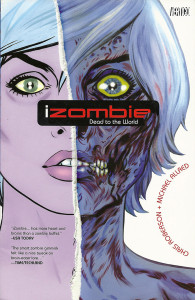-J. Michael Bestul is a writer for the Addison Recorder. Stephanie Ruehl is an artist who works in a comic book shop. They’re married and have a lot of discussions about comic books and graphic novels. Combine all that into a biweekly feature and you get “J. & Steph Talk About Comics.”
Modern comics are a medium of iconography and archetypes, whether reinforcing or re-inventing them (or re-booting them, or cashing in on them…). The Bat-symbol carries worlds of meaning to countless fans, but which version of the symbol? Is your Iron Man the Tony Stark of Kirby & Lee, Fraction & Bendis, or Robert Downey, Jr.? What’s your opinion of the last Superman flick? Do you have a think-piece on all the differences between Jessica Jones in the comics and on Netflix?
While we have thoughts on those questions, we decided it would be more fun to focus on the re-imaginings, re-interpretations, and re-envisionings that piqued our interest over the years.
Vanessa Marianna (Fisk) – Daredevil (TV series)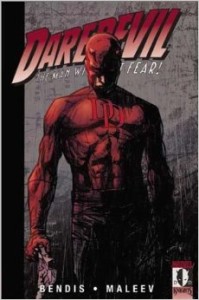
-J.: I don’t always read Marvel titles, but when I do, I prefer Daredevil
Steph: Heh…
-J.: Daredevil took hold of me as a series and as a character under the skilled pencils of Brian Michael Bendis, David Mack, Alex Maleev, and Ed Brubaker. There was a grittiness and willingness to look into the mistakes and contradictions of the Catholic lawyer and horned vigilante. I was glad to see that the recent Netflix series seemed to draw from their interpretation of Matt Murdock and Wilson Fisk. What intrigued me was the presentation of Vanessa Marianna, the woman who charmed the Kingpin.
Vanessa Fisk was a (very) minor character during most of the history of Daredevil titles, up until she returns during Bendis’ run on the series. Bendis (and Brubaker) took the devoted wife of Fisk, who hated his criminal activity, a nd brought about a dark edge to her character. The Netflix series draws from these depictions of Vanessa, but re-envisions her in a more nuanced portrayal by Ayelet Zurer.
nd brought about a dark edge to her character. The Netflix series draws from these depictions of Vanessa, but re-envisions her in a more nuanced portrayal by Ayelet Zurer.
This Vanessa is a focused art dealer who looks directly at the violence and terrifying determination of Wilson Fisk, and walks hand-in-hand with him and it. Rather than the woman in the comics who forces Fisk to choose between her or his pursuit of power, Vanessa Marianna seems on a trajectory more akin to Lady Macbeth: inspiring, understanding, and sharing in the Kingpin’s grab for power.
Liv Moore/Gwen Dylan – iZombie
Steph: I knew of iZombie before the CW television series, mainly because of the covers for each issue. I had never read the Chris Roberson-written series, but Michael Allred’s covers always caught my eye. I finally decided to pick up the trades just before the show aired so I could see what might’ve been in store, and to compare Liv’s transition from comics to television.
Liv Moore (get it? Live More… it’s a play on words-never mind) is a medical examiner with the Seattle PD who, when she consumes brains, can remember specific memories of her meals, and uses those memories to solve their murders. That’s pretty much where the similarities between the book and show end. Gwen Dylan of the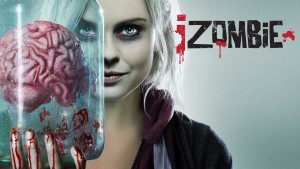 book is a gravedigger whose only friends are a ghost named Ellie and a were-terrier nicknamed Spot. The book itself is full of supernatural creatures and plots, while the show is a bit more straightforward as a procedural. The creator of the show, Rob Thomas (who also created Veronica Mars), has relied heavily on that archetype. Essentially it’s like they took the title, the look, and the brain-induced visions and made something completely different with it.
book is a gravedigger whose only friends are a ghost named Ellie and a were-terrier nicknamed Spot. The book itself is full of supernatural creatures and plots, while the show is a bit more straightforward as a procedural. The creator of the show, Rob Thomas (who also created Veronica Mars), has relied heavily on that archetype. Essentially it’s like they took the title, the look, and the brain-induced visions and made something completely different with it.
But these differences don’t detract from either the source or the new TV series. iZombie has become one of my favorite shows, with Liv being one of the most complex and, ironically, human characters in current pop culture.
Tara Chace – Queen & Country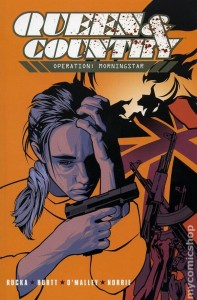
-J.: Tara Chace isn’t a literal re-interpretation of a character, but a modern take on a classic genre archetype. You know the type: the deadly and gifted British secret agent who survives dangerous operations with aplomb. Though I had a soft spot for James Bond, I never fully bought into the stylized espionage of 007. I was more taken by noir of The Third Man, but even that genre always felt of another era.
Tara Chace is the super-spy of the contemporary landscape. She is death and sex and brilliance on par with Bond, but part of an organization that would look more familiar to a fan of The Sandbaggers than Fleming’s version of the British SIS. Instead of the Cold War, however, her operations are in a world that is both more grey and yet more stark. She is the protagonist of Greg Rucka’s Queen & Country, which looked at the aftermath and human costs of secret intelligence in the early years of the ’00s.
It’s also the series that told human stories in the midst of struggles involving groups like the Taliban, when most readers might only know them as militants that destroyed millennia-old wonders half a world away. It’s also the series that told stories of post-9/11 espionage and terrorism without resorting to the easy fascism and black-and-white approach of a 24.
Patsy/Trish Walker – Jessica Jones
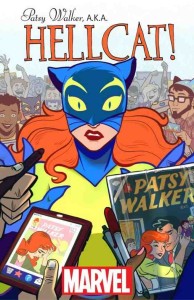 Steph: I had the pleasure of getting to know the character of Patsy Walker in the recent short-lived She-Hulk series. Patsy, aka Hellcat, is an out-of-work superhero who becomes She-Hulk’s (a.k.a. Jennifer Walters’) employee in her new law firm. Helping Jen fight bad guys at night and serve summons during the day, they were an all-around fantastic duo.
Steph: I had the pleasure of getting to know the character of Patsy Walker in the recent short-lived She-Hulk series. Patsy, aka Hellcat, is an out-of-work superhero who becomes She-Hulk’s (a.k.a. Jennifer Walters’) employee in her new law firm. Helping Jen fight bad guys at night and serve summons during the day, they were an all-around fantastic duo.
-J.: I miss that duo.
Steph: Patsy was older character than I realized, and has led an interesting life. Created by Ruth Atkinson in 1944 for Miss America Magazine, she’s since been a scientist, an Avenger, a Defender, she’s been to hell (literally), and soon will have her own comic series Patsy Walker aka Hellcat! in March of 2016.
Patricia ‘Patsy’ Walker is a trained martial artist, who is tough and snarky, and I just
love her. Patricia ‘Trish’ Walker, played by Rachael Taylor in the new Netflix series Jessica Jones (created by Melissa Rosenberg and based on Alias by Brian Michael Bendis and Michael Gaydos), is a credit to the source. Trish is a strong willed-woman who refuses to let anyone make a victim of her. After Jessica, her adopted (and super-powered) sister and protector vanishes for months, Trish takes it upon herself to learn Krav Maga. In a way their relationship reminds me of the Hellcat/She-Hulk team. With her quick wit, her unending love and support of Jessica, and her brave nature, Patsy/Trish Walker is a character to be admired.
credit to the source. Trish is a strong willed-woman who refuses to let anyone make a victim of her. After Jessica, her adopted (and super-powered) sister and protector vanishes for months, Trish takes it upon herself to learn Krav Maga. In a way their relationship reminds me of the Hellcat/She-Hulk team. With her quick wit, her unending love and support of Jessica, and her brave nature, Patsy/Trish Walker is a character to be admired.
Starman, the Shade, and the JSA
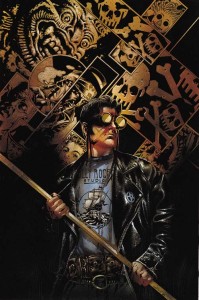 -J.: Back before the debacle of “The New 52,” DC Comics understood the draw of icons and legacy characters. Writers like Geoff Johns and James Robinson revived long-dormant mantles with a new generation of heroes, best exemplified by the Starman and JSA series. In Starman, Jack Knight reluctantly takes up his dad’s mantle and legacy after Jack’s brother is assassinated as the latest Starman. It’s a series that has a meta-narrative of superhero legacies and what icons mean, but makes sure to have the meta- take a back seat to deep characters who evolve as the years pass. I could go on at length at
-J.: Back before the debacle of “The New 52,” DC Comics understood the draw of icons and legacy characters. Writers like Geoff Johns and James Robinson revived long-dormant mantles with a new generation of heroes, best exemplified by the Starman and JSA series. In Starman, Jack Knight reluctantly takes up his dad’s mantle and legacy after Jack’s brother is assassinated as the latest Starman. It’s a series that has a meta-narrative of superhero legacies and what icons mean, but makes sure to have the meta- take a back seat to deep characters who evolve as the years pass. I could go on at length at
The same goes for the JSA series from the early ’00s, which delved into what it means to take up a legacy in an era far different than those who created the mantle. The plots were infused by the tension that legacy characters experience, struggling to live up to an idealized archetype and yet be more than a mere echo of that archetype. Man, they (DC) don’t make comics like that any more…
To Sum It All Up…
As much as we roll our eyes at Big Two reboots, or cringe at the thought of another half-assed Fantastic Four movie, good storytellers can cover an original archetype in a way that brings out new discoveries and nuances. Thankfully, the comic book medium has a lot of opportunities for good storytellers to play their riff upon the classic icons.

